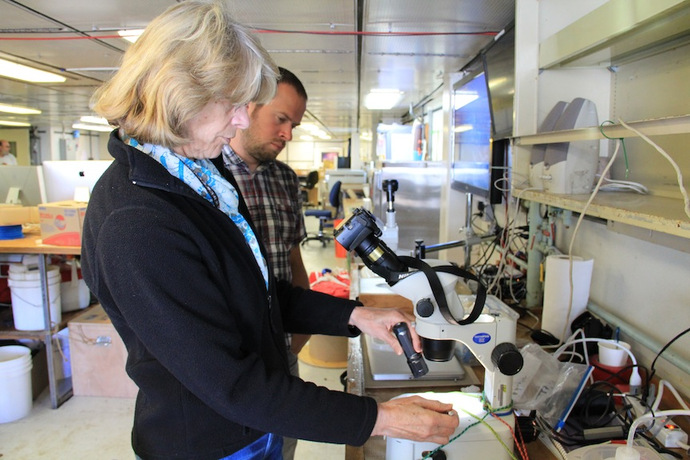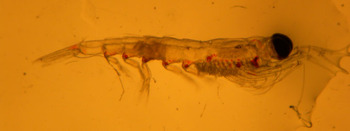Kendra Daly, an OOI-RSN Senior project Scientist, is onboard conducting plankton net tows to obtain samples for her ongoing study on zooplankton viruses. Below, she describes why understanding viral loads in zooplankton is so important in order to better understand the dynamics of marine food webs.
Mesozooplankton are critical components of marine food webs as the primary consumers of phytoplankton, as prey for upper trophic level predators including commercially important fish, and by mediating carbon transfer from the atmosphere to the ocean interior through fecal matter deposition. Thus, the factors that control population dynamics of zooplankton are critical to understanding the structure and function of marine food webs. Two decades of research on marine viruses have demonstrated their profound effects on all levels of marine life from bacteria to whales. The majority of marine virus studies have focused on infection of microorganisms, particularly heterotrophic prokaryotes and eukaryotic phytoplankton. Despite the ecological importance of zooplankton, virtually nothing is known about the impact of viruses or causes of natural morality.
Viruses are small particles, usually about 20–200 nm long, consisting of genetic material (DNA or RNA, single- or double- stranded) surrounded by a protein coat (some also have lipids). They have no intrinsic metabolism, and function only as parasites through the cellular machinery of a host organism. Marine viruses, which maintain abundances of 106 – 108 virus-like particles ml-1
in surface seawater; however, because free viruses decay rapidly in seawater (2 - 4% h-1), they are believed to primarily infect bacterioplankton as they are the dominant available hosts. The mechanisms by which viruses infect mesozooplankton may differ from mechanisms of viruses infecting unicellular microorganisms.
My co-Principle Investigators, Dr. Mya Brietbart and Dr. Ian Hewson, and I are prospecting for novel viruses in dominant and ecologically important zooplankton species using metagenomic sequencing approaches and through amplification and sequencing of genes conserved among groups of invertebrate viruses. Much of our work is focused on zooplankton in Florida coastal waters where we are determining the prevalence, seasonal variability, viral load, and tissue specificity for selected copepod viruses. In addition, I am taking the opportunity offered by the VISIONS'11 cruise to collect zooplankton for virus detection in the NE Pacific. Overall, our proposed work will provide the first glimpse into mesozooplankton-virus interactions, increasing our knowledge of the impacts of viruses on marine communities, and providing modelers with critical data for incorporating viral infection of zooplankton into population dynamic models.




